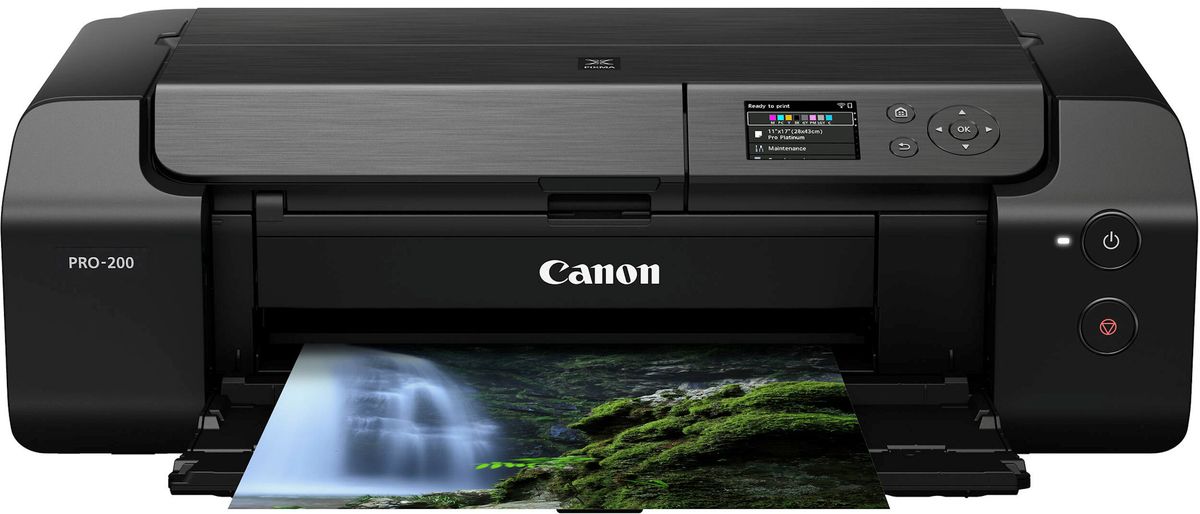Digital Camera World Verdict
There’s no beating dye-based inks for an ultra-smooth finish on glossy photo paper. With eight separate inks under the bonnet, the PIXMA PRO-200 picks up the baton from the preceding PRO-100S model, upping its game with a revamped ink formulation to enhance print quality, a more intuitive interface that adds a 3-inch color screen, and a higher-precision paper transport system. For inkjet photo printing on glossy paper, it reigns supreme.
Pros
- +
Spectacular print quality on glossy paper
- +
Fast print speeds in all quality modes
- +
Enables borderless output on both glossy and matte media
Cons
- -
Ink cartridge capacity is a little meagre
- -
Deep blacks aren’t quite as impressive as with Canon’s PRO-300 printer
- -
Not the ideal choice for matte and fine art media
Why you can trust Digital Camera World
The Canon PIXMA PRO-200 is the successor to one of the best photo printers ever. Canon’s PIXMA PRO-100S has long been our favorite A3+/13-inch pro-grade printer for creating photo prints on glossy paper. Running on eight dye-based inks, including black, grey and light grey, it delivered sumptuously smooth glossy prints with immaculate color rendition, along with very convincing tonal expression for black & white photographic images. The replacement PRO-200 brings a number of improvements and enhancements, similar to those of the imagePROGRAF PRO-300 pigment-based printer in comparison to the older PIXMA PRO-10S model.
Specifications
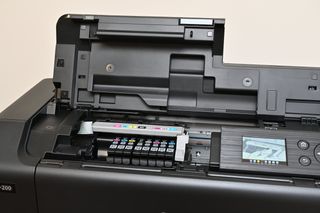
Inks/type: 8x dye
Printer head width: 13in
Max print size: A3+/13x39in
Max print resolution: 4800x2400dpi
Input trays: 1x upright rear, 1x manual feeder
Scanner: None
Display screen: 3-inch color LCD
Interfaces: Hi-speed USB, Ethernet, Wi-Fi
Dimensions (WxDxH): 639x379x200mm
Weight: 14.1kg
• See also Best Canon printers
Key features
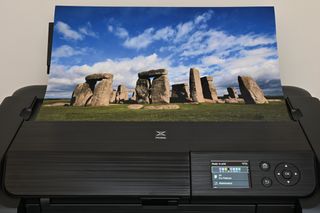
For outright print quality, the headline upgrade in the PRO-200 is that it has a new and improved range of inks. The color line-up is nominally the same as that of the older PRO-100S, consisting of eight dye based inks including cyan, photo cyan, magenta, photo magenta, yellow, black, grey and light grey. As such, it outstrips a conventional six-ink photo printer, delivering a more generous gamut (or color space) for color printing, as well as greater tonal range for mono photo printing, with the promise of banishing unwanted color casts.
The new set of inks have been reformulated to further increase the gamut, especially in the magenta, red and blue sectors, along with improving color reproduction in dark areas. Higher density black is also on tap, enabling really rich lowlights in both color and mono photo prints.
The PRO-200 looks almost identical to Canon’s latest imagePROGRAF PRO-300 pigment-based A3+/13-inch printer and, indeed, there are many similarities between the two. Both have an upgraded OIG System (Optimum Image Generating System) that works out the best combination of inks to use for every color and tone, on the fly, with great speed and precision. New gamut mapping models are also employed to ensure the best match between what you see on screen and what you get in print. Both printers have a dedicated ‘Black and White Photo’ print mode for enhanced mono quality.
Further similarities include onboard controls based around a 3-inch color LCD screen, an automatic, upright sheet feeder at the rear, under which there’s a manual feed tray that’s more ideal for thicker fine art media and panoramic or banner printing on cut sheets, up to 39 inches (990.6cm) in length. A front-feeding tray is also supplied for printing directly onto white-faced CDs, DVDs and Blu-ray discs, as well as for using specialist media like Canon’s stick-on printable fingernail covers. Getting back to the main paper feed, an automatic skew correction mechanism is now fitted, to ensure that paper sticks to the straight and narrow on its way through the printers.
Unlike previous models, both printers are able to create borderless output on matte photo media instead of just on glossy paper. Canon’s excellent Professional Print & Layout software is available as a free download, which works as a standalone program or as a plug-in for Adobe Lightroom and Photoshop. More on that later. The printers are fully compatible with a large range of top-quality fine art media from the likes of Canson and Hahnemühle, for which ICC profiles are readily available.
Build and handling
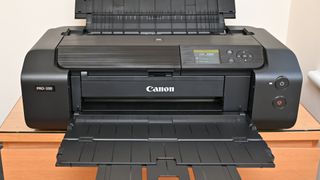
Despite being quite compact, build quality is extremely good, with a really robust and well-made feel to all of the component parts. The colour LCD screen is a useful addition, as it helps guide you through the initial setup process and enhances handling by making available standalone adjustments to settings and routine maintenance tasks like print head alignment, nozzle checks and print head cleaning routines.
Adjustment of the paper width guides is quick and easy to do, and the guides themselves automatically retract slightly during printing, to avoid any interference with the paper during its transit.
Well connected, the printer features High-speed USB and wired Ethernet ports, as well as both 2.4GHz and 5GHz built-in Wi-Fi. The companion Professional Print & Layout software makes it easy to create custom multi-image layouts on a single sheet of paper, as well as fine-tuning the output. For the latter soft-proofing and hard-proofing options are available, including the ability to create a grid of slightly different thumbnail versions of an image on a ‘contact sheet’, so you can pick your favourite for the final print. A Media Configuration Tool is also available for adding profiles for additional media from Canon and other manufacturers.
Performance
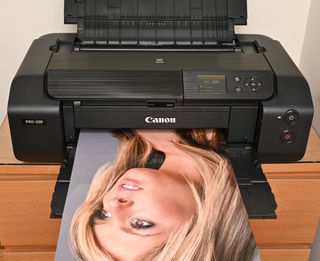
A key advantage of most dye-based printers over pigment-based models is that print speeds are quicker. It might not sound important if you’re creating a prized print to last a lifetime but, if you need to create several or more prints in one session, it can make a real difference. The overall speed of the process is also enhanced by the fact that, unlike with pigment-based prints, the ink is fully absorbed beneath the outer layer of glossy photo paper, so prints are touch-dry even as they leave the printer and can be handled immediately.
In our tests, the PRO-200 proved very quick, even for a dye-based printer. For borderless colour output on glossy paper, it took 33 seconds to create a 4x6-inch print in standard photo quality mode, stretching to 1 minute 10 seconds for A4 and 2 minutes 51 seconds for A3+ respectively. In high quality photo mode, a borderless A3+ glossy colour print took 4 minutes 15 seconds but any improvement in print quality was very hard to discern without using a high-magnification loupe. Using the Black & White Photo mode, which utilises fewer ink colours, print speeds are slower. We found that the standard quality setting for an A3+ black & white print gave an identical print speed to using the high quality color mode.
In terms of running costs, the PRO-200 is pretty reasonable. Its ink cartridges have a capacity of 12.6ml each, which isn’t great for a large-format printer. By way of comparison, the ‘XXL’ dye-based cartridges available for Canon’s smaller A4/8.5-inch PIMXA TS6350/6320 and TS 8350/8320 printers have nearly the same capacity of 11.7ml. As such, you can find yourself needing to replace cartridges quite often and, if you’re into the usual mix of color printing, it’ll be the yellow, photo cyan and photo magenta cartridges that you need to change most often. Even so, running costs are modest, working out to around $4.00/ £3.30 per A3+/13x19-inch colour photo print for ink alone, or $6.40/£5.25 if you add good-quality own-brand Canon glossy photo paper into the equation.
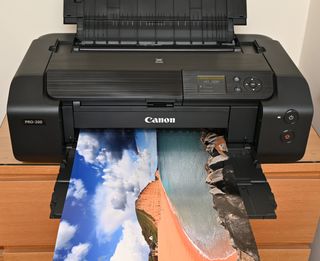
For actual glossy print quality, while the imagePROGRAF PRO-300 gives unusually good output on glossy paper for a pigment-based printer, thanks to its ‘chroma optimizer’ cartridge for smoothing things over, it’s no match for the PIXMA PRO-200. The PRO-200 wins out for vivid color with real pop, and an ultra-smooth finish with no discernible bronzing whatsoever. It’s not only a clear winner out of the two, but also beats every other inkjet printer on the market. True to its promise, blacks and dark colours are wonderfully deep and rich, while very light, airy colors are reproduced accordingly.
For black & white photo printing, the PRO-200 does a superb job, again creating really deep blacks. However, the PRO-300 wins out here, especially on matte and fine art media, not only with its pigment-based inks but also because it features matte black as well as ‘photo black’ inks.
Verdict
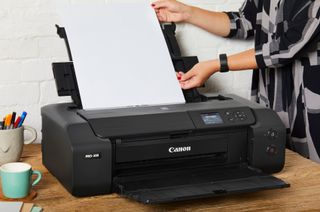
The Canon PRO-200 delivers spectacular print quality for both color and mono photographic images on glossy, semi-gloss and lustre papers. It also does incredibly well for a dye-based printer on matte and fine art media. Print speeds are very impressive and, overall, the printer is a stellar performer in every respect. It’s also really well-built and has great handling characteristics. Even so, if output on matte and fine art media is most important to you, and glossy paper is further down your list, the imagePROGRAF PRO-300 will suit you better.
Read more:
• The best photo printer: desktop photo printers compared
• The best large format printer
• The best photo printing online: top services from around the web
• Best wireless printers
Matthew Richards is a photographer and journalist who has spent years using and reviewing all manner of photo gear. He is Digital Camera World's principal lens reviewer – and has tested more primes and zooms than most people have had hot dinners!
His expertise with equipment doesn’t end there, though. He is also an encyclopedia when it comes to all manner of cameras, camera holsters and bags, flashguns, tripods and heads, printers, papers and inks, and just about anything imaging-related.
In an earlier life he was a broadcast engineer at the BBC, as well as a former editor of PC Guide.

